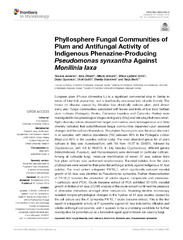Приказ основних података о документу
Phyllosphere Fungal Communities of Plum and Antifungal Activity of Indigenous Phenazine-Producing Pseudomonas synxantha Against Monilinia laxa
| dc.creator | Janakiev, Tamara | |
| dc.creator | Dimkić, Ivica | |
| dc.creator | Unković, Nikola | |
| dc.creator | Ljaljević-Grbić, Milica | |
| dc.creator | Opsenica, Dejan M. | |
| dc.creator | Gašić, Uroš M. | |
| dc.creator | Stanković, Slaviša | |
| dc.creator | Berić, Tanja | |
| dc.date.accessioned | 2019-12-06T15:49:40Z | |
| dc.date.available | 2019-12-06T15:49:40Z | |
| dc.date.issued | 2019 | |
| dc.identifier.issn | 1664-302X | |
| dc.identifier.uri | https://cherry.chem.bg.ac.rs/handle/123456789/3729 | |
| dc.description.abstract | European plum (Prunus domestica L.) is a significant commercial crop in Serbia in terms of total fruit production, and is traditionally processed into slivovitz brandy. The brown rot disease caused by Monilinia laxa drastically reduces plum yield almost every year. Fungal communities associated with leaves and fruits of four local Serbian plum cultivars (Požegača, Ranka, Čačanska Lepotica and Čačanska Rodna) were investigated in two phenological stages during early (May) and late (July) fruit maturation. Alpha diversity indices showed that fungal communities were heterogeneous and Beta diversity indicated that autochthonous fungal communities depended upon seasonal changes and the cultivars themselves. The phylum Ascomycota was the most abundant in all samples, with relative abundance (RA) between 46% in the Požegača cultivar (May) and 89% in the Lepotica cultivar (July). The most abundant genus for all plum cultivars in May was Aureobasidium, with RA from 19.27 to 33.69%, followed by Cryptococcus, with 4.8 to 48.80%. In July, besides Cryptococcus, different genera (Metschnikowia, Fusarium, and Hanseniaspora) were dominant on particular cultivars. Among all cultivable fungi, molecular identification of eleven M. laxa isolates from four plum cultivars was performed simultaneously. Bacterial isolates from the plum phyllosphere were tested for their potential antifungal activity against indigenous M. laxa isolates. The most potent antagonist P4/16_1, which significantly reduced mycelial growth of M. laxa, was identified as Pseudomonas synxantha. Further characterization of P4/16_1 revealed the production of volatile organic compounds and phenazine-1-carboxylic acid (PCA). Crude benzene extract of PCA exhibited 57–63% mycelial growth inhibition of M. laxa. LC/MS analysis of the crude extract confirmed the presence of phenazine derivatives amongst other compounds. Scanning electron microscopy revealed morpho-physiological changes in the hyphae of M. laxa isolates caused by the cell culture and the P. synxantha P4/16_1 crude benzene extract. This is the first report of antagonistic activity of P. synxantha against M. laxa induced by diffusible and volatile antifungal compounds, and it appears to be a promising candidate for further investigation for potential use as a biocontrol agent against brown rot-causing fungi. | |
| dc.publisher | Frontiers Media S.A. | |
| dc.relation | info:eu-repo/grantAgreement/MESTD/Basic Research (BR or ON)/173026/RS// | |
| dc.rights | openAccess | |
| dc.rights.uri | https://creativecommons.org/licenses/by/4.0/ | |
| dc.source | Frontiers in Microbiology | |
| dc.subject | biocontrol | |
| dc.subject | fungal diversity | |
| dc.subject | Monilinia laxa | |
| dc.subject | NGS | |
| dc.subject | plum cultivars | |
| dc.subject | Pseudomonas synxantha | |
| dc.title | Phyllosphere Fungal Communities of Plum and Antifungal Activity of Indigenous Phenazine-Producing Pseudomonas synxantha Against Monilinia laxa | |
| dc.type | article | |
| dc.rights.license | BY | |
| dcterms.abstract | Гашић, Урош М.; Јанакиев, Тамара; Димкић, Ивица; Унковић, Никола; Берић, Тања; Љаљевић-Грбић, Милица; Опсеница, Дејан М.; Станковић, Славиша; | |
| dc.citation.volume | 10 | |
| dc.identifier.wos | 000491276800001 | |
| dc.identifier.doi | 10.3389/fmicb.2019.02287 | |
| dc.citation.rank | M21~ | |
| dc.description.other | Supplementary material: [http://cherry.chem.bg.ac.rs/handle/123456789/3730] | |
| dc.type.version | publishedVersion | |
| dc.identifier.scopus | 2-s2.0-85073698169 | |
| dc.identifier.fulltext | https://cherry.chem.bg.ac.rs/bitstream/id/16310/Phyllosphere_Fungal_Communities_pub_2019.pdf |


